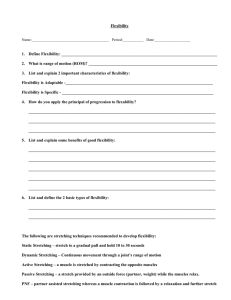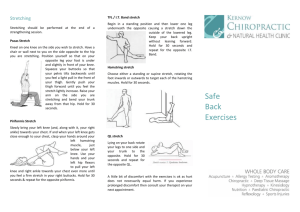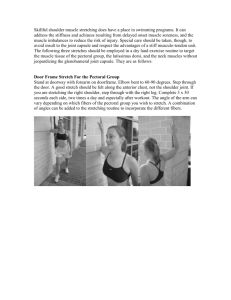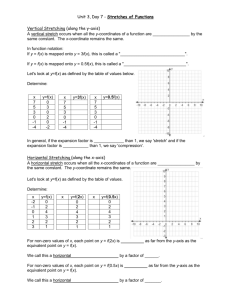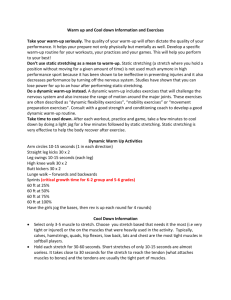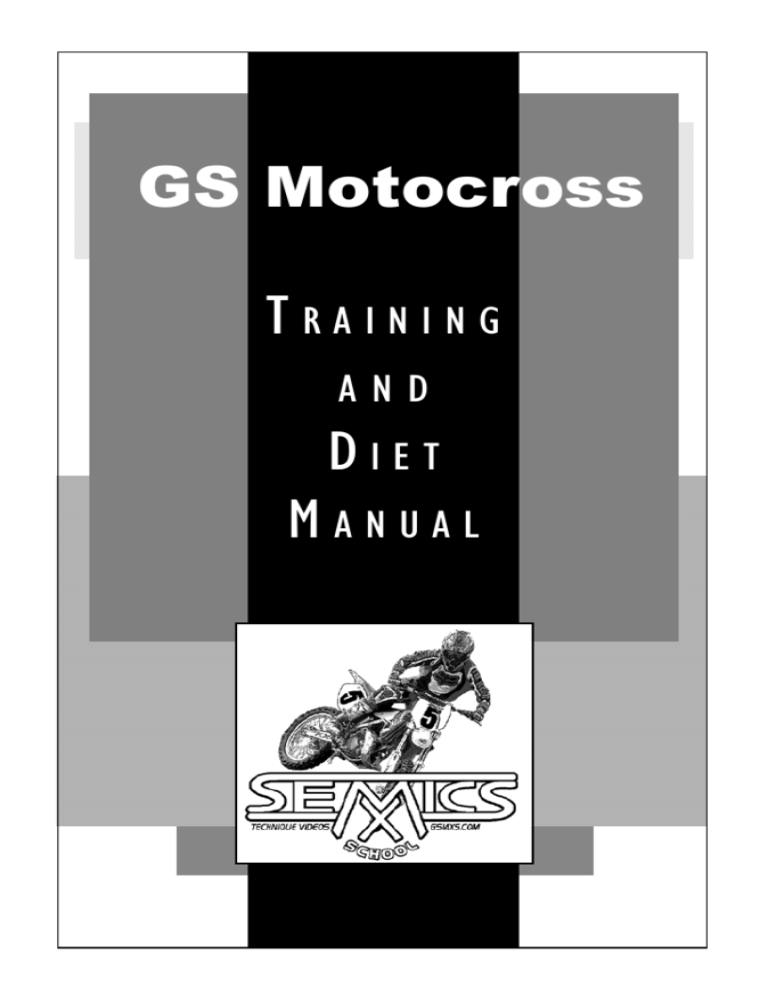
GS Motocross
TRAINING
AND
DIET
MANUAL
© Copyright 2003 by Gary Semics. All rights reserved. The entire contents
of this book are the copyright of Gary Semics and may not be reproduced,
transmitted in any shape or form, without expressed written permission
from the publisher, Gary Semics. Brief passages may be quoted for the
purpose of review. Printed in the USA.
The information contained in this book is designed to give a person the
information in order to be better able to get in good physical shape but there
are no guarantees. Training can result in bodily injury or death, the responsibility of any bodily injury, death, or property damage rest solely on the
reader.
Table of Contents
Intense Endurance Weight Training Program 1 ............... pg. 1
Aerobic Weight Training Program 2 .................................. pg. 2
Overall Body Strength Training Program .......................... pg. 3
Motocross Specific Program 1 ........................................... pg. 4
Examples of Workouts Using Cross Training Methods ..... pg. 5
GS Calisthenics .................................................................. pg. 6
Stretching ........................................................................... pg. 7
Stretching Methods ............................................................ pg. 8
Stretching Program ............................................................ pg. 8
Abdominal Work ................................................................ pg. 9
GS Abdominal Work .......................................................... pg. 9
Training When Sick ........................................................... pg. 10
Diet Information ................................................................. pg. 12
Complex Carbohydrates..................................................... pg. 15
Proteins ............................................................................... pg. 15
Fats and Oils ...................................................................... pg. 16
Junk Food ........................................................................... pg. 16
Vitamin and Mineral Supplements ................................... pg. 17
Meal Samples ..................................................................... pg. 18
How to Fuel Up on Race Day ............................................ pg. 20
Intense Endurance Weight Training Program 1 for M-X
(Always do a light warm-up and cool down for 8 to 10 minutes before and after).
EXERCISE
R EPS
1) BENCH PRESS Super Set 1 and 2
1st set
“FA” 15
2) LAT PULL DOWNS
REPS
2nd set 3rd set
15
15
15
3) SQUATS OR LEG PRESS Super set 3, 4, & 5 15
15
4) CALF RAISES
REPS
leg press
“LP” 15 do
on last set
“FA” 15 “FA” 15
5) DUMBBELL WINGS (side 30 degrees)
15
6) SITTING CABLE ROWS
15
30-35
7) DECLINE DUMB-BELL BENCH PRESS 30-35
8) ABB WORK of your choice
9) LEG CURL MACHINE SUPER SET 9 & 10
10) LEG E XTENSION MACHINE
15
15
15
“FA” 15 “FA” 15
11) UPPER DEAD L IFTS
15 “CR” 15
12) BAR BELL C URLS HALF REVERSE 30-35
13) TRICEP CABLE PRESS
“FA” ::: Fore arm sets.
“CR” ::: Calf raises
30-35
Forearm sets are described in Technique Video #6
(Eliminating Arm Pump).
This program should be done once or twice a week, no later than
Thursday if you’re racing on Sunday
1
Aerobic Weight Training Program 2
In this program you want to alternate between aerobic exercise and
weights. Do weight exercises with a semi fast smooth rhythm and never wait or
stop until program is finished. Set the weight so you can get 15 reps. For the
aerobic portion it’s best to alternate between the Schwinn Air Dyne and running,
(mostly use the Air Dyne). Program time - 1 hour 20 min. Cut this program back the
second part of the week. Something like, just 1 through 12.
Sometimes you may want to do
some stretching after your warm
up and/or the six calisthenics.
1) 10 MIN. WARM UP (RUN OR AIR DYNE IS BEST)
2) LAT PULL DOWNS
15
3) BENCH PRESS
15
4) LEG PRESSES OR SQUATS AND CALF RAISES
15
5) SITTING C ABLE ROWS
15
6) DUMBBELL WINGS (SIDE 30 DEGREES)
15
7) LEG CURLS AND L EG EXTENSIONS
15
8) UPPER DEAD LIFTS
15
9) HANGING AB RAISES OR SOME KIND OF AB WORK
15
10) STRAIGHT ARM LAT PULL DOWNS
15
11) TRICEPS EXTENSIONS AND BICEP CURLS
15
12) LUNGES
24
ALTERNATE LEGS
13) AEROBIC EXERCISE 10 MINUTE ROWING MACHINE, AIR DYNE, OR RUN
14) Weight Circuit
10 reverse grip each
15) Aerobic Exercise
number 13 again
2 thru 12 again
2
Overall Body Strength Training Program for M-X
This overall body program should be done twice per week.
Begin with 5 min. warm up. End with 5 min. warm down (some kind of cardio).
Exercise
Reps
1st set
Reps
2nd set
Reps
3rd set
15
15
15
15
15
15
3) SQUATS OR LEG PRESS SUPER SET 3, 4 & 5 15
15
15
4) CALF RAISES
15 “FA” 15
“FA” 15
5) DUMBBELL WINGS (side 30 degrees)
15
15
6) INCLINE B ENCH P RESS SUPER SET 6 & 7
15
15
7) SITTING CABLE ROWS
15
15
“FA” 15
15
1) DUMBBELL B ENCH PRESS
SUPERSET 1 & 2
“FA”
2) LAT P ULL DOWNS
8) LEG CURLS SUPER SET 8 & 9
9) LEG EXTENSIONS
15
10) UPPER DEAD L IFTS SUPER SETS 10 & 11
15
15
11) DUMBBELL ROTATOR CUFF
15
15
15
12) ABB WORK OF YOUR CHOICE
13) CURLBAR CURLS SUPER SET 13 & 14
reverse grip each set
20 10
or 15 sitting dumbbell curls
14) Tricept Cable Press
20 10 reverse grip each
15) Chest Flys
15
16) Shoulder Shruggs
15
“FA” ::: Fore arm sets.
“CR” ::: Calf raises
Forearm sets are described in Technique Video #6
(Eliminating Arm Pump). Workout time: 60 min.
Motocross Specific Program 1
In this program you want to alternate between aerobic exercise and
weights. Do weight exercises with a semi fast smooth rhythm and never wait or
stop until program is finished. Set the weight so you can get 15 to 18 reps, accept for
motocross push-up & ab work, you should be able to do more. For the aerobic
portion it’s best to alternate between the Schwinn Air Dyne and running. (Mostly
use the Air Dyne). Program time - 50 min. Cut this program back the second part
of the week. Something like, one set of weights and two, five or 10 minute segments of cardio.
1) 10 M IN. WARM UP (RUN OR AIR DYNE IS BEST)
THE SIX CALLISTHENIC EXERCISES
A. MOTOCROSS PUSHUPS D. SQUATS OR LEG PRESS
B. STANDING CABLE ROWS E. CALF RAISES
C. AB WORK
F. STRAIGHT ARM LAT PULL INS
2) 2ND CARDIO (RUN, AIR DYNE, ETC. (10 MIN.)
THE SIX CALLISTHENIC EXERCISES
A. MOTOCROSS PUSHUPS D. SQUATS OR LEG PRESS
B. STANDING CABLE ROWS E. CALF RAISES
C. AB WORK
F. STRAIGHT ARM LAT PULL INS
3) 3RD C ARDIO (RUN, AIR DYNE, ETC. (10 MIN.)
Workout time: 50 min.
4
Examples of Workouts Using Cross Training Methods
AIR D YNE (JUST USING ARMS)
10 MINUTES
RUN
10 MINUTES
AIR DYNE (ARMS AND LEGS)
10 MINUTES
RUN
10 MINUTES
TOTAL TIME
40 MINUTES
This is just one example. You can try different time combinations and
see what you like. Then according to the way you want to train at that time you
adjust your intensity and duration.
Another great principle to use with these training methods is “INTERVAL
TRAINING”. Interval training is usually a Tear Down Training. Inverval Training
should target all the large muscles of the body so you can max out the heart and
lungs. Therefore the best training methods to use again are the Schwinn Air Dyne
and Running.
An Example of Interval Training
1. Warm-up on Air Dyne for 6 to 10 minutes
2. Light run for 2 to 4 minutes
3. Sprint 120 yards and job back. As soon as you get back sprint the
120 yards again. Repeat 6 to 8 times.
4. Air Dyne level 6 for 1 minute
Level 3 for 1 minute
Level 7 for 1 minute
Level 3 for 1 minute
Level 8 for 1 minute
Level 3 for 1 minute
Continue to alternate between levels 3 and 8 five more times.
Each time you do level 3 and 8 it counts as one time.
This total workout should take between 40 and 50 minutes.
5
GS
Calisthenics
These GS Calisthenics are a great way to warm up
before practice and racing. They are also good to do at different
points during some of my other workouts because they move
your body in different ways and are a form of light cardio and
stretching. These calisthenics will seem awkward to you at
first. Stick with them and learn them well because there is a
good effective reason behind all of them and the way in which
they work together. There are six of these calisthenic
exercises. They should be done one right after the other. Most
of the time do 20 of each accept for the bounce jumps do 50
total and go all the way down into a full squat every 10.
Sometimes it’s good to cut the reps in half when you’re doing
it frequently during a workout. An example would be like if
you’re doing the calisthenics five times during a workout you
can do the full amount the first and last times and do half the
amount the three times between.
These calisthenic exercises may seem a little awkward
at first but the more you do them the better they will feel. Once
you get used to them they will feel good to you and be a great
way to warm up and get ready for action.
TIBBLIN WINDMILL
20 REPS
STRETCH KICKS
20 REPS
GS SIDE FLEX
20 REPS
BOUNCH JUMPS
50 REPS
BOXER
20 REPS
GS BUTTERFLY
20 REPS
6
Stretching
Motocrossers develop bad posture from working in a
hunched over riding position. The most common bad postures
developed by motocross racers are rounded shoulders and
goose necks. This stretching program will keep your posture
in balance. Don’t let this stretching part of the program go
undone or you may end up like I did with chronic neck and
back pain. Then I had to go on a very strict rehabilitation
program in order to become pain free again.
Stretching is an important part of any athlete’s training
regimen. A motocross racer should have a high range of
flexibility. This will help prevent injuries and allow a racer to
perform better, to ride looser without getting tight. Stretching
is a great technique to use during recovery. Therefore, I believe
the best times to stretch is before bed and on your easy training
days or recovery days. You should do a lot of stretch (20
minutes) at least five days per week. Stretching is not only
good for the muscles; it’s good for the entire body, even the
mind. What’s your attitude towards stretching? Instead of
sitting there on the couch watching TV, get down there on the
floor and stretch. The following stretching program will keep
all your muscles loose, balanced and ready for action.
7
Stretching
Methods
Take your time and relax when stretching. Many of
these stretches will seem awkward to you at first, but it’s like
anything new, the more you do it the better you’ll get at it. Hold
each stretch for at least 10 seconds and repeat the stretch at
least two times. On some of the stretches you may want to
hold longer, up to one minute, then you would just need to do
that stretch one time. There’s also a method called a
resistance stretch. Perform the stretch the regular way for
the first 10 seconds, and then turn the muscles that you’re
stretching on slightly for about five seconds. Then relax them
and stretch them a little farther for about five more seconds.
Repeat back and forth up to four times. When you turn the
muscles on in the resistance stretch only use about 20% of
your strength. This resistance stretch will cause the muscles
to relax more during the relaxed part of the stretch and stretch
even farther. You can do the resistance stretch on any of the
stretches where you think it applies. I’ve marked RS beside
each one that I like to do it on.
Stretching
Program
1. Sitting Splits
2. Sitting Side Splits
3. Sitting Feet Bottoms Together
4. Sitting Legs Crossed
5. Sitting Knee to Elbow Turn a Rounds
6. Curled Up Back Rolls
(bent and straight legged)
7. Laying Ankle To Knee Pull
8. Sitting 90 Degree Hip Flex. (RS)
9. Standing Splits
10. Back Bend from Knees
11. Laying Flat Leg Overs
12. Dog and Cat
13. Back Roller
14. Dura Ball Back Bends
15. Dura Ball Side Bends
16. Dura Ball Peck Stretch (RS)
17. Dura Ball Quad Stretch (RS)
18. Doorway Stretch
19. Triceps Stretch
20. Back of Neck Stretch (RS)
21. Front of Neck Stretch
Abdominal
(what you should know)
Work
In motocross (or anything for that matter) it’s very
important to have a lot of core strength. Core strength comes
from the center of your body. This comprises of the hips,
gluts, low back and the abdominal areas. It’s impossible to
have a strong core without having strong abs, abs and low
back work together. Some of the conventual ab exercises are
actually over stressful on the upper thighs and low back. Two
prime examples are regular sit-ups and straight leg lifts. In
some people they can cause forward pelvis tilt and low back
stress. I am one of the people who are prone to this common
problem, so I adapted and developed the following six ab
exercises that are user friendly. However, many people can’t
even do these correctly at first. If you are one of these people
don’t get discouraged, instead get determined because they
will make your core much stronger over time.
GS
Abdominal
Work
1. Lower Ab Crunches (Vertical Leg Lifts)
2. Elbow to Knee Crunches
3. Regular Crunches
4. Dura Ball Side Crunches
5. Hanging Ab Raises
6. Hanging Side Ab Raises
Branden doing Dura Ball Side Crunches
9
Training
When
Sick
Beside injuries and bike problems, getting sick is right
up there with some serious performance problems. I’ve heard
of some athletes, mostly bicycle racers who try to keep
training when they begin to get sick and end up getting sicker,
sometimes for as long as six months. I have been to the
school of hard knocks on this one and learned the hard way
that continuing to ride and/or train when I felt myself starting
to get sick was not the wise choice.
I was really determined to do well my first full season
in Europe back in 1982. After a short break I started training
hard on January 1st. Somewhere around the middle of the
month I started to get a cold. I was all into the training mode
and thought I’ll just train this cold right out of me. Although I
did cut back a little, for the most part I keep right on training.
To make a long story short I ended up getting a very deep viral
and bacterial infection that I just couldn’t get rid of until June
(six months later). By the time I arrived in Europe in March to
start testing and getting ready for the Grand Prix to start I was
very sick with infected fluid in my lungs. Now I didn’t have a
choice, I had to perform or give up and go home. I couldn’t do
any type of supplement training; I just practiced, tested and
raced. It was a steep and slippery climb to stay competitive
and continue. I sure wished many times that I had rested
back in January when I had a choice, but instead, I sent myself
through another semester in the school of hard knocks.
The wise choice is to stop all riding and training when
you first feel yourself getting sick. Catching it right when the
virus or bacteria is first starting to wage its war is most critical.
When this begins to happen your body calls on it’s immune
system troops to attack the invading organisms trying to
multiply and take over. Your body’s immune system goes
into red alert mode. This is when your body needs to rest so
10
it can do its thing and kill off the invaders before they get a
strong hold. In this situation one of the many amazing things
your immune system does is create way more white blood
cells. White blood cells contain the solders that fight the
invaders. If you rest you allow your body to do this and many
other tasks to win the war. In other words, your energies are
being used on the inside. When you ride or train you’re making
your body produce more red blood cells, which carry oxygen
for your muscles and outward energies. You may temporarily
feel better, but the invaders are winning the internal war. When
you stop training or riding and return to a restful state your
body will go back to the internal war at the cost of a big set
back. Then the invaders are going to be around for a while.
At the least until you finally have to let yourself rest and your
immune system finishes them off.
What if you can’t just rest when you feel yourself
getting sick? What if you have to work or race or something
like that? Well then you gotta do what you gotta do, but many
times a rider will be in the middle or beginning of the week
and not have to ride or train or do anything physically stressful.
But they don’t really feel that bad yet and maybe they had
plans to go riding with someone or go to the gym. It would be
boring to change plans and do something restful. This is
where they end up getting sick for a week or more when they
could have taken one or two days off and been right back in
the saddle. Worse yet, they have to travel and race when
they are really sick. It’s not smart and it’s not worth it in the
long run. If you have a choice when you start feeling like you’re
coming down with something take it easy and let your body
do its work.
You can greatly decrease your odds of catching an
infection by not touching your face in public, and washing your
hands often, especially in public places. Colds and flu viruses
and bacterial infections are out there by the millions. Although
some are contagious thorough the air, most of them are only
contagious by direct contact. So you touch a doorknob and
then wipe your eye or pick your nose and you could have just
implanted a contagious germ. They can even be taken in
through the ear. You would think that the mouth would also
be a likely pathway, but not if the germ gets swallowed, your
stomach’s defenses are way too powerful for most of these
types of germs and they are terminated in short order.
A good diet and supplements, awareness, patients and
common sense can go a long way in keeping you well.
Diet
Information
Any serious athlete should be serious about diet.
There are many benefits to a good diet including; feeling better
and having more energy, faster recovery times, reaching higher
levels of fitness more quickly, having a stronger immune
system, looking better and staying at your ideal weight and
having better health in general for a longer life. One of the
keys to a good diet is common sense and moderation. You
don’t have to be an extremist but being health conscience with
some general knowledge, good decisions (from the available
choices) and becoming aware of how certain foods affect you
personally, you can tune into a better diet and recieve many
benefits. Everyone is a little different and has to discover the
combinations that work best for them and those combinations
come from the following basic facts about nutrition.
1. The closer the food is to natural, organic, just how nature
made it, the better it is for you. The more it’s been processed
and altered by man the worse it is for you.
2. Five or six smaller meals a day are better than one or two
large meals. Give your food time to digest before going to
bed or exercising.
3. Fresh fruits and vegetables should be the main staple of your
diet.
12
4. Over cooking (heat) foods robs them of most, if not all, of their
nutrients.
5. It is very important for an endurance athlete like a M-Xer to
keep themselves fueled up with the right kinds of food at the
right times. Before exercise or competition you should not
feel heavy or full but at the same time you should have enough
fuel stored in your body for your energy to last. This means
you should have eaten something between a half hour and
one and a half hours before hand depending on how much
you ate.
6. For most athletes 70% of your diet should be complex
carbohydrates, 20% protein, and 10% fats and oils.
7. Water soluble foods are foods that have their own water
content in them. These are mostly fruits and vegetables. Our
bodies are mostly made up of water. These foods are
extremely important to have in your daily diet. And it’s very
beneficial to drink a lot of water between meals. For weight
loss eat a lot of water soluble foods and cut back on fats, oils,
and dairy products.
8. Make it a habit to read the ingredient labels and learn what’s
good, not so good, and bad. Stay away from foods that have
long ingredient lists, lots of preservatives, or added vitamins
and minerals. They have to try and add them because after
so much processing there’s none left.
9. A good balanced regimen of all the essential vitamins and
minerals should also supplement your diet. (See vitamin and
mineral supplement section)
10. Add a half cup of raw, milled flax seed to your daily diet. (1/4
cup in morning and 1/4 cup in evening. Flax seed can be
found at most health food stores.) Flax seed is high in protein,
carbohydrates, fiber and most importantly it’s very high in
Omega 3 oils. Omega 3 oils are very good for the
cardiovascular system. The only other food sources that have
these important Omega 3 oils in them are fish, nuts, and
seeds.
11. I have stressed the importance of eating a lot of fresh fruits
and vegetables. They are so important that they deserve
even more information. A very important imgredient that is
only found in raw fruits, vegetables and grains are live enzymes.
Heat destroys these live enzymes, so the only way we can get
them is in uncooked fruits, vegetables or grains.
12. What are live enzymes? Emzymes are protein-based
substances that are found in every cell of every living plant
and animal, including the human body. Without these life
giving enzymes life would not exist. All things living have
enzymatic activity, even the food you eat (if the enzymes haven’t
been killed yet by processing and cooking). Basically enzymes
run your metabolism and many other important body activities.
Trust me; a lot of fresh fruits and vegetables is the way to go.
Without getting into too much detail these are some
good guidlines to start from. It’s important for everyone to
make their health and diet an on going learning process.
Everyone should take responsibility for their own health. Learn
all you can about nutrition and apply what works best for you.
But a word of Warning, don’t get so caught up in it that it
becomes a hassle and a lot of trouble every time you need to
eat. That may become more harmful than good. Eat to live,
don’t live to eat. Our bodies are an ever changing field of
energy. It’s not just the amounts of nutritients we put into our
bodies, it’s the amount that our bodies can absorb and utilize
that’s most important. Every cell in our bodies is brand new
every year. Feed yourself well so you can regenerate
effectively. Add years to your life and life to your years.
Remember, common sense and moderation.
14
Complex
Carbohydrates
Complex carbohydrates supply energy for the
repeated muscular contractions that occur during prolonged
exercise. They are the fuel which the muscles run on.
Carbohydrates are stored in the muscles and also in the
liver in the form of glycogen. If the muscles are depleted of
glycogen the athlete will fatique.
Sources of Complex Carbohydrates
1. Fresh fruits and vegetables (the best source)
2. Breads - made from whole grains
3. Pasta - made from whole wheat, soy or semonlina flours
4. Whole grain flours - whole wheat, buckwheat, cornmeal and rye
5. Grains - brown rice, barley, millet, oats, wild rice, cracked wheat
6. Dried legumes - peas , lentils, beans, corn, seeds and nuts
7. Whole grain cereals - rolled oats, shredded wheat, mueseli,
granola, bran and wheat germ
Proteins
Proteins are the building blocks of the body. Muscle
tissue is torn down through exercise. Protein is necessary
to rebuild it. The body can also use protein as fuel, but it’s
not as efficient as carbohydrates or fats. Proteins are the
most difficult food to digest and your body can only use so
much at a time, that’s why it should only be up to 20% of
your diet.
All proteins are made up of amino acids. Twenty two
amino acids have been identified as necessary for biological
growth and survival. Fourteen of these amino acids are
termed “non-essential” because the human body can
manufacture them. Eight can be obtained only from food
sources and are thus termed the “essential” amino acids.
Sources of Amino Acids
Meats, Poultry, Dairy Products, Nuts and Seeds, Eggs, Fish
and Seafood, Beans, Vegetables
Fats
and Oils
Fats are essential for digestion and storage of nutrients for the body. They lubricate the vital organs, joints,
muscles and skin. Fats are either saturated or unsaturated.
Natural vegetable oils are rich sources of unsaturated fats and
are preferred to the saturated animal fats to reduce cholesterol levels. Unsaturated fats are the natural vegetable oils.
Sources of unsaturated fats
Olive oil, Safflower oil, Corn oil, Soybean oil, Peanut oil,
Cottonseed oil, Wheat germ, nuts and flax seeds, Mayonnaise
Sources of saturated fats
(try to avoid these)
Fat from meats (beef, pork, poultry, fish), Butter, Cream, Lard
Junk
Food
Junk food will rob you of strength, energy, your body’s
ability to regenerate, and in the long run your health.
Junk Foods, Cut Them Out
Fried food (french fries, fish and chips, potato chips, etc)
Refined flours (white bread, pastries, cookies, cakes,
doughnuts, etc)
Refined sugar, corn sweetener
Sugar substitutes (saccharine, cyclamate)
Candy
Chocolates
Alcoholic Beverages
Coffee
Carbonated soft drinks
16
Vitamin
Mineral
and
Supplements
1) Beta Carotene 25,000 I.U.
2) B-Complex 50 (covers all B vitamins)
3) C with Bioflavonoids (1000 mg C with 100 mg
Biioflavonoids) (Capsules)
4) E 400 I.U.
5) Multi-mineral including the 72 trace minerals (You’ll probably have to get the 72 trace minerals seperate)
6) Omega-3 Fatty Acids (Capsule form) (Some sources are:
Fish Body oils and Salmon oil, there are some others
from plants and seeds - 1000 mg)
7) Echinacea and Goldenseal - (500 mg) (Try to get both in
one product. This is a product that you don’t stay on
all the time)
8) Grape Seed Antioxidant - (60 mg 1 to 3 times a day)
9) Shark Cartilage - (4.5 grams)
10) Glucosamine and Chondroitin Sulfate - (500 mg of each)
(if you have joint pain) This is mostly for us older riders.
Get a store worker to help you find everything you
need. GNC is not the best place to shop. A natural health
food store, like Henry’s or others, usually have better products and prices.
Read all directions and begin by taking as they suggest. On the Echinacea and Goldenseal you should never
take it longer than two weeks at a time. Only take it when you
feel that you may be starting to get a cold or something and
while you are sick.
17
Meal
Samples
Breakfast
Try not to drink a log of liquids with meals, unless you’re very
dehydrated, especially coffee or tea. They dilute digestive
juices. Go easy on margarine, butter, maple syrup, etc.
1. A 32 to 50 oz. smoothy made from fresh fruit. Pick several of your
favorite fruits and toss them into a blender, add just enough fruit
juice to make it blend. It’s good to add one half handful of raw
almonds and a 1/4 cup of miled flax seed. When you can’t do
the smoothie, following are some options. Or you can add a little
of these to your smoothie breakfast.
2. Oatmeal, toast and eggs or a good grain cereal (should add fruit)
3. French toast and eggs or pancakes and eggs
4. Rice eggs and toast or potatoes, eggs and toast
Lunch
The salad should be made from good green lettuce or spinach and some raw vegetables. Olive oil is very healthy so
add it to your salads. Vinegar is also good. You can have a
little of your other favorite dressings on there, too.
1. Salad, sandwich and fruit
2. Salad, pasta and bread
3. Salad, fish and rice
4. Salad, beans and rice
5. Tuna salad, soft boiled eggs and bread
6. Salad, chicken or steak, potatoes, corn or peas
7. Another smoothie and a soft boiled egg. Or fruit, soft boiled egg
and almonds
18
Dinner
Dinner is similar to lunch. Except you want dinner to
be the best protein meal of the day, so eat hardy; your body
restores iteself the most while you sleep. Always try to eat
dinner early (before 8:00 p.m.). You don’t want to go to bed
on a full stomach.
If you have a difficult time keeping enough weight on,
balance your meals with more carbohydrates. As mentioned
earlier, it’s important to have 5 or 6 smaller meals a day. The
best way to do it is to have three larger meals a day from the
above selections and have several smaller meals throughout the day derived from any combination of the above. Fruit
and some almonds is usually the best way to go for you’re
between meal snacks. With the breakfast smoothies and
then eating more fruit throughout the day, you can see that,
well, you should be eating a lot of fruit.
If you really do the diet thing right, it will still take about
two weeks before you can expect to see noticeable benefits.
It’s not going to happen in just a few days. So stick to the
plan.
19
How To
Fuel up on Race Day
Day Race
There are a lot of sports nutrition products on the market today,
all kinds of bars and powders. If you couldn’t eat real food these products
would be the next best thing. But so far there is no substitute better than
real food.
Eat a good breakfast from the breakfast examples.
Now, for the rest of the day, you want to time your food intake into
the longest breaks between practice and each of your motos.
Your next meal could be something like: Fruit, almonds and
a soft boiled egg, or a turkey sandwich with lettuce, tomatoes and
mayonnaise.
Your third and fourth food intakes could be a little more of the
above or a peanut butter and jelly sandwich.
The best things to drink through race day are:
Water and/or a sport energy drink like Gatorade, Poweraid,
Ultra Fuel, etc. When it’s really hot and your drinking a lot it’s best to
lean out sports drinks about 50% water to 50% sport drink.
These guidelines will keep you fueled up so you have plenty of
energy throughout race day and at the same time you’ll feel light and
ready for action.
Night Race
The best food intake for night races is very similar to day races.
Now you have time to eat a good breakfast and lunch. Then, instead of
eating dinner, you would eat the same as the day race meal plan starting
after breakfast.
You should have plenty of fuel stored up in your body coming into
race day, and this plan will keep your reserves from running out. You will
also recover faster and be able to train more effectively throughout the
following week.
You may not be totally what you eat, but your cells are. Do it right,
it makes a difference, how much of a difference? You’ll have to see for
yourself.
20
Become a better rider with my techniques
dvds and schools because they are backed
with years of pro racing and coaching
experience. You will learn what I continue
to learn from the top pros that I’ve trained:
Jer
emy McGrath, Kevin W
indham, R
yan
Ryan
Jeremy
Windham,
ock Sellar
ds,
Villopoto, Ezra Lusk, John Dowd, Br
ock Hepler
Hepler,, Br
Brock
Sellards,
Brock
Stephan Roncada, Ernesto Fonsaca, Mike Brown, Brandon
Jesseman and many others.
Welcome to The Gar
oss School and DVDs
Garyy Semics Motocr
Motocross
The school that trains the top pros and hundreds of amateurs every year.
“Former Supercross Champion Gary Semics’ motocross
schools and instructional dvds are among the most
highly respected in the industry” - Dirt Bike Magazine
Born in 1954, Former Supercross Champion Gary Semics has
been training Jeremy McGrath, Kevin Windham, Ryan Villopoto,
Ezra Lusk, John Dowd, Brock Hepler, Brock Sellards, Stephan
Roncada, Ernesto Fonsaca, Mike Brown, Brandon Jesseman and
other top pro racers. Gary stays current with all the new techniques
and fundamentals that are being used today. The technique dvds
break these techniques down in a way that is easy to understand
and put to use. Stop action, slow motion, and graphics are used
so you can see exactly what is happening as you hear Gary
explaining it. Gary himself, many of the top M-X stars, as well as
beginners and amateurs are in these dvds. The dvds are fun and
entertaining to watch, but more importantly “YOU WILL
BECOME A BETTER RIDER”.
21
Visit our website for:
• Free DVD Previews
• Riding Tips
• Motocross School Schedules
• Order DVD Hard Copies or
• DVD Downloads
and much more at
www.garysemics.com
Gary Semics Motocross Schools and Technique DVDs
37316 Eagleton Road
Lisbon, Ohio 44432
E-Mail: cindy@gsmxs.com
gary@gsmxs.com
Office: 330-424-8049
www.garysemics.com
22
Motocross Push-Ups
Motocross Pull-Ins
worksconnection.com
sdgusa.com
dunloptires.com
maximausa.com
renthal.com
factoryconnection.com
foxracing.com
vpracingfuels.com
twinair.com
wiseco.com
leovinceusa.com
scottusa.com
alpinestars.com

